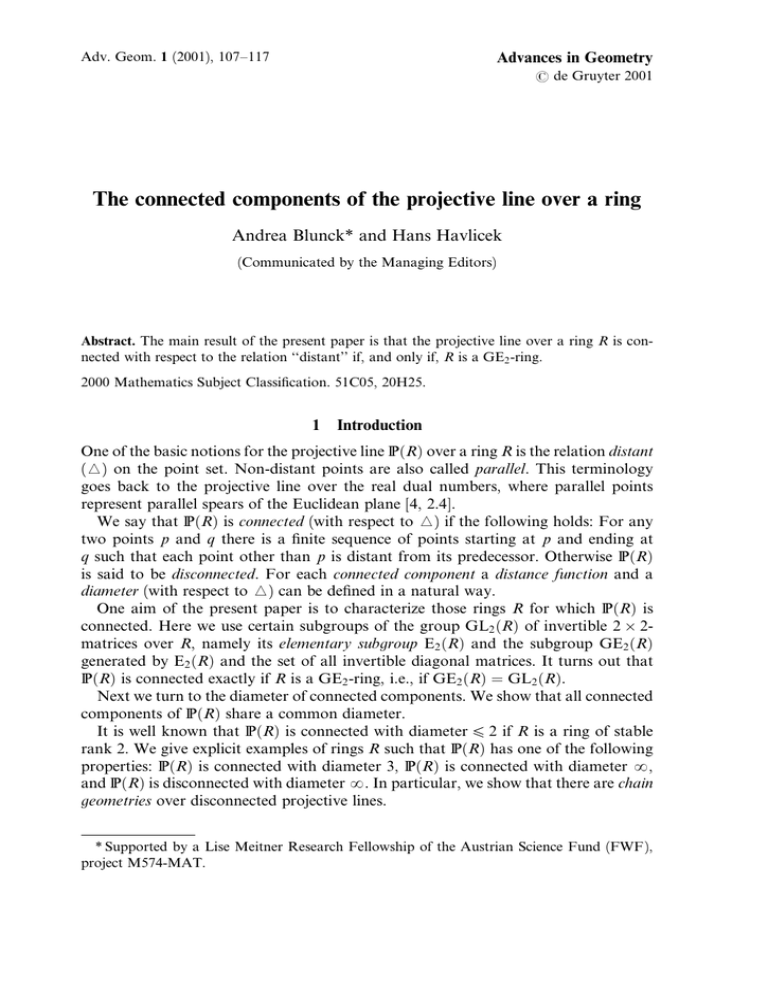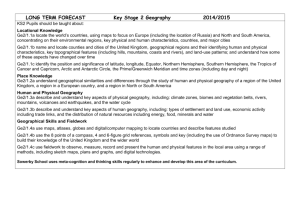The connected components of the projective line over a ring
advertisement

Advances in Geometry Adv. Geom. 1 (2001), 107±117 ( de Gruyter 2001 The connected components of the projective line over a ring Andrea Blunck* and Hans Havlicek (Communicated by the Managing Editors) Abstract. The main result of the present paper is that the projective line over a ring R is connected with respect to the relation ``distant'' if, and only if, R is a GE2 -ring. 2000 Mathematics Subject Classi®cation. 51C05, 20H25. 1 Introduction One of the basic notions for the projective line P R over a ring R is the relation distant (h) on the point set. Non-distant points are also called parallel. This terminology goes back to the projective line over the real dual numbers, where parallel points represent parallel spears of the Euclidean plane [4, 2.4]. We say that P R is connected (with respect to h) if the following holds: For any two points p and q there is a ®nite sequence of points starting at p and ending at q such that each point other than p is distant from its predecessor. Otherwise P R is said to be disconnected. For each connected component a distance function and a diameter (with respect to h) can be de®ned in a natural way. One aim of the present paper is to characterize those rings R for which P R is connected. Here we use certain subgroups of the group GL2 R of invertible 2 2matrices over R, namely its elementary subgroup E2 R and the subgroup GE2 R generated by E2 R and the set of all invertible diagonal matrices. It turns out that P R is connected exactly if R is a GE2 -ring, i.e., if GE2 R GL2 R. Next we turn to the diameter of connected components. We show that all connected components of P R share a common diameter. It is well known that P R is connected with diameter W 2 if R is a ring of stable rank 2. We give explicit examples of rings R such that P R has one of the following properties: P R is connected with diameter 3, P R is connected with diameter y, and P R is disconnected with diameter y. In particular, we show that there are chain geometries over disconnected projective lines. * Supported by a Lise Meitner Research Fellowship of the Austrian Science Fund (FWF), project M574-MAT. 108 Andrea Blunck and Hans Havlicek 2 Preliminaries Throughout this paper we shall only consider associative rings with a unit element 1, which is inherited by subrings and acts unitally on modules. The trivial case 1 0 is not excluded. The group of invertible elements of a ring R will be denoted by R . Firstly, we turn to the projective line over a ring: Consider the free left R-module R 2 . Its automorphism group is the group GL2 R of invertible 2 2-matrices with entries in R. A pair a; b A R 2 is called admissible, if there exists a matrix in GL2 R with a; b being its ®rst row. Following [14, p. 785], the projective line over R is the orbit of the free cyclic submodule R 1; 0 under the action of GL2 R. So P R : R 1; 0GL2 R or, in other words, P R is the set of all p W R 2 such that p R a; b for an admissible pair a; b A R 2 . As has been pointed out in [8, Proposition 2.1], in certain cases R x; y A P R does not imply the admissibility of x; y A R 2 . However, throughout this paper we adopt the convention that points are represented by admissible pairs only. Two such pairs represent the same point exactly if they are left-proportional by a unit in R. The point set P R is endowed with the symmetric relation distant (h) de®ned by h : R 1; 0; R 0; 1GL2 R : 1 Letting p R a; b and q R c; d gives then a b phq , A GL2 R: c d In addition, h is anti-re¯exive exactly if 1 0 0. The vertices of the distant graph on P R are the points of P R, the edges of this graph are the unordered pairs of distant points. Therefore basic graph-theoretical concepts are at hand: P R can be decomposed into connected components (maximal connected subsets), for each connected component there is a distance function (dist p; q is the minimal number of edges needed to go from vertex p to vertex q), and each connected component has a diameter (the supremum of all distances between its points). Secondly, we recall that the set of all elementary matrices 1 t 1 0 and B21 t : with t A R 2 B12 t : 0 1 t 1 generates the elementary subgroup E2 R of GL2 R. The group E2 R is also generated by the set of all matrices t 1 3 E t : B12 1 B21 ÿ1 B12 1 B21 t with t A R; ÿ1 0 The connected components of the projective line over a ring 109 since B12 t E ÿt E 0ÿ1 and B21 t E 0ÿ1 E t. Moreover, we have E tÿ1 E 0 E ÿt E 0, which implies that all ®nite products of matrices E t already comprise the group E2 R. The subgroup of GL2 R which is generated by E2 R and the set of all invertible diagonal matrices is denoted by GE2 R. By de®nition, a GE2 -ring is characterized by GL2 R GE2 R; see, among others, [10, p. 5] or [18, p. 114]. 3 Connected components We aim at a description of the connected components of the projective line P R over a ring R. The following lemma, although more or less trivial, will turn out useful: Lemma 3.1. Let X 0 A GL2 R and suppose that the 2 2-matrix X over R has the same ®rst row as X 0 . Then X is invertible if, and only if, there is a matrix M 1 s 0 u A GE2 R 4 such that X MX 0 . 1 0 : M for some s; u A R. Further, Proof. Given X and X then XX s u 0 X MX is invertible exactly if u A R . This in turn is equivalent to (4). 0 0ÿ1 Here is our main result, where we use the generating matrices of E2 R introduced in (3). Theorem 3.2. Denote by Cy the connected component of the point R 1; 0 in the projective line P R over a ring R. Then the following holds: (a) The group GL2 R acts transitively on the set of connected components of P R. (b) Let t1 ; t2 ; . . . ; tn A R, n X 0, and put x; y : 1; 0 E tn E tnÿ1 E t1 : 5 Then R x; y A Cy and, conversely, each point r A Cy can be written in this way. (c) The stabilizer of Cy in GL2 R is the group GE2 R. (d) The projective line P R is connected if, and only if, R is a GE2 -ring. Proof. (a) This is immediate from the fact that the group GL2 R acts transitively on the point set P R and preserves the relation h. (b) Every matrix E ti appearing in (5) maps Cy onto Cy , since R 0; 1 A Cy goes over to R 1; 0 A Cy . Therefore R x; y A Cy . 110 Andrea Blunck and Hans Havlicek On the other hand let r A Cy . Then there exists a sequence of points pi R ai ; bi A P R, i A f0; 1; . . . ; ng, such that R 1; 0 p0 h p1 h h pn r: 6 Now the arbitrarily chosen admissible pairs ai ; bi are ``normalized'' recursively as follows: First de®ne xÿ1 ; yÿ1 : 0; ÿ1 and x0 ; y0 : 1; 0. So p0 R x0 ; y0 . Next assume that we already are given admissible pairs xj ; yj with pj R xj ; yj for all j A f0; 1; . . . ; i ÿ 1g, 1 W i W n. From Lemma 3.1, there are si A R and ui A R such that xiÿ1 ai yiÿ1 bi 1 si 0 ui xiÿ1 yiÿ1 ÿxiÿ2 ÿyiÿ2 ! : 7 ÿ1 ÿ1 By putting xi : uÿ1 i ai , yi : ui bi , and ti : ui si we get xi ÿxiÿ1 yi ÿyiÿ1 E ti xiÿ1 ÿxiÿ2 yiÿ1 ÿyiÿ2 8 and pi R xi ; yi . Therefore, ®nally, xn ; yn is the ®rst row of the matrix G 0 : E tn E tnÿ1 E t1 A E2 R; 9 and r R xn ; yn . (c) As has been noticed at the end of Section 2, the set of all matrices (3) generates E2 R. This together with (b) implies that E2 R stabilizes Cy . Further, R 1; 0 remains ®xed under each invertible diagonal matrix. Therefore GE2 R is contained in the stabilizer of Cy . Conversely, suppose that G A GL2 R stabilizes Cy . Then the ®rst row of G, say a; b, determines a point of Cy . By (5) and (9), there is a matrix G 0 A E2 R and a unit u A R such that a; b 1; 0 uG 0 . Now Lemma 3.1 can be applied to G and uG 0 A GE2 R in order to establish that G A GE2 R. (d) This follows from (a) and (c). From Theorem 3.2 and (9), the connected component of R 1; 0 A P R is given by all pairs of 1; 0 E2 R or, equivalently, by all pairs of 1; 0 GE2 R. Each product (5) gives rise to a sequence xi ; yi 1; 0 E ti E tiÿ1 E t1 ; i A f0; 1; . . . ; ng; 10 which in turn de®nes a sequence pi : R xi ; yi of points with p0 R 1; 0. By putting pn : r and by reversing the arguments in the proof of (b), it follows that (6) is true. So, if the diameter of Cy is ®nite, say m X 0, then in order to reach all points of Cy it is su½cient that n ranges from 0 to m in formula (5). The connected components of the projective line over a ring 111 By the action of GL2 R, the connected component Cp of any point p A P R is GL2 R-equivalent to the connected component Cy of R 1; 0 and the stabilizer of Cp in GL2 R is conjugate to GE2 R. Observe that in general GE2 R is not normal in GL2 R. Cf. the example in 5.7 (c). All connected components are isomorphic subgraphs of the distant graph. 4 Generalized chain geometries If K H R is a (not necessarily commutative) sub®eld, then the K-sublines of P R give rise to a generalized chain geometry S K; R; see [7]. In contrast to an ordinary chain geometry (cf. [14]) it is not assumed that K is in the centre of R. Any three mutually distant points are on at least one K-chain. Two distinct points are distant exactly if they are on a common K-chain. Therefore each K-chain is contained in a unique connected component. Each connected component C together with the set of K-chains entirely contained in it de®nes an incidence structure S C. It is straightforward to show that the automorphism group of the incidence structure S K; R is isomorphic to the wreath product of Aut S C with the symmetric group on the set of all connected components of P R. If S K; R is a chain geometry then the connected components are exactly the maximal connected subspaces of S K; R [14, p. 793, p. 821]. Cf. also [15] and [16]. An R-semilinear bijection of R 2 induces an automorphism of S K; R if, and only if, the accompanying automorphism of R takes K to uÿ1 Ku for some u A R . On the other hand, if P R is disconnected then we cannot expect all automorphisms of S K; R to be semilinearly induced. More precisely, we have the following: Theorem 4.1. Let S K; R be a disconnected generalized chain geometry, i.e., the projective line P R over R is disconnected. Then S K; R admits automorphisms that cannot be induced by any semilinear bijection of R 2 . Proof. (a) Suppose that two semilinearly induced bijections g1 ; g2 of P R coincide on all points of one connected component C of P R. We claim that g1 g2 . For a proof choose two distant points R a; b and R c; d in C. Also, write a for that projectivity a b ÿ1 is a semilinearly induced which is given by the matrix . Then b : ag1 gÿ1 2 a c d bijection of P R ®xing the connected component Cy of R 1; 0 pointwise. Hence R 1; 0, R 0; 1, and R 1; 1 are invariant under b, and we get R x; y b R x z u; y z u for all x; y A R 2 with z A Aut R and u A R , say. For all x A R the point R x; 1 is distant from R 1; 0; so it remains ®xed under b. Therefore x uÿ1 x z u or, equivalently, x z u ux for all x A R. Finally, R x; y b R ux; u y R x; y for all x; y A R 2 , whence g 1 g2 . 112 Andrea Blunck and Hans Havlicek (b) Let g be a non-identical projectivity of P R given by a matrix G A GE2 R, for example, G B12 1. From Theorem 3.2, the connected component Cy of R 1; 0 is invariant under g. Then p 7! p g for all p A Cy 11 d : P R ! P R : p 7! p for all p A P RnCy is an automorphism of S K; R. The projectivity g and the identity on P R are different and both are linearly induced. The mapping d coincides with g on Cy and with the identity on every other connected component. There are at least two distinct connected components of P R. Hence it follows from (a) that d cannot be semilinearly induced. If a cross-ratio in P R is de®ned according to [14, 1.3.5] then four points with cross-ratio are necessarily in a common connected component. Therefore, the automorphism d de®ned in (11) preserves all cross-ratios. However, cross-ratios are not invariant under d if one adopts the de®nition in [4, p. 90] or [14, 7.1] which works for commutative rings only. This is due to the fact that here four points with cross-ratio can be in two distinct connected components. We shall give examples of disconnected (generalized) chain geometries in the next section. 5 Examples There is a widespread literature on (non-)GE2 -rings. We refer to [1], [9], [10], [11], [12], [13], and [18]. We are particularly interested in rings containing a ®eld and the corresponding generalized chain geometries. Remark 5.1. Let R be a ring. Then each admissible pair x; y A R 2 is unimodular, i.e., there exist x 0 ; y 0 A R with xx 0 yy 0 1. We remark that x; y A R 2 unimodular ) x; y admissible 12 is satis®ed, in particular, for all commutative rings, since xx 0 yy 0 1 can be interpreted as the determinant of an invertible matrix with ®rst row x; y. Also, all rings of stable rank 2 [19, p. 293] satisfy (12); cf. [19, 2.11]. For example, local rings, matrix rings over ®elds, and ®nite-dimensional algebras over commutative ®elds are of stable rank 2. See [13, 4.1B], [19, x2], [20], and the references given there. The following example shows that (12) does not hold for all rings: Let R : KX ; Y be the polynomial ring over a proper skew ®eld K in independent central indeterminates X and Y. There are a; b A K with c : ab ÿ ba 0 0. From X a Y bcÿ1 ÿ Y b X acÿ1 1; the pair X a; ÿ Y b A R 2 is unimodular. However, this pair is not admissible: Assume to the contrary that X a; ÿ Y b is the ®rst row of a matrix The connected components of the projective line over a ring 113 M A GL2 R and suppose that the second column of M ÿ1 is the transpose of v0 ; w0 A R 2 . Then P : f v; w A R 2 j X av ÿ Y bw 0g v0 ; w0 R: On the other hand, by [17, Proposition 1], the right R-module P cannot be generated by a single element, which is a contradiction. Examples 5.2. (a) If R is a ring of stable rank 2 then P R is connected and its diameter is W2 [14, Proposition 1.4.2]. In particular, the diameter is 1 exactly if R is a ®eld and it is 0 exactly if R f0g. As has been pointed out in [2, (2.1)], the points of the projective line over a ring R of stable rank 2 are exactly the submodules R t2 t1 1; t2 of R 2 with t1 ; t2 A R. Clearly, this is just a particular case of our more general result in Theorem 3.2 (b). Conversely, if an arbitrary ring R satis®es (12) and P R is connected with diameter W 2, then R is a ring of stable rank 2 [14, Proposition 1.1.3]. (b) The projective line over a (not necessarily commutative) Euclidean ring R is connected, since every Euclidean ring is a GE2 -ring [13, Theorem 1.2.10]. Our next examples are given in the following theorem: Theorem 5.3. Let U be an in®nite-dimensional vector space over a ®eld K and put R : EndK U. Then the projective line P R over R is connected and has diameter 3. Proof. We put V : U U and denote by G those subspaces W of V that are isomorphic to V =W . By [5, 2.4], the mapping F : P R ! G : R a; b 7! f u a ; u b j u A Ug 13 is bijective and two points of P R are distant exactly if their F-images are complementary. By an abuse of notation, we shall write dist W1 ; W2 n, whenever W1 ; W2 are F-images of points at distance n, and W1 h W2 to denote complementary elements of G. As V is in®nite-dimensional, 2 dim W dim V dim W for all W A G. We are going to verify the theorem in terms of G: So let W1 ; W2 A G. Put Y12 : W1 V W2 and choose Y23 W W2 such that W2 Y12 l Y23 . Then W1 V Y23 f0g so that there is a W3 A G through Y23 with W1 h W3 . By the law of modularity, W2 V W3 Y23 Y12 V W3 Y23 Y12 V W3 Y23 : Finally, choose Y14 W W1 with W1 Y12 l Y14 and Y34 W W3 with W3 Y23 l Y34 . Hence we arrive at the decomposition V Y14 l Y12 l Y23 l Y34 : As W2 A G, so is also W4 : Y14 l Y34 . Now there are two possibilities: 14 114 Andrea Blunck and Hans Havlicek Case 1: There exists a linear bijection s : Y14 ! Y23 . We de®ne Y : fv v s j v A Y14 g. Then Y14 , Y23 , and Y are easily seen to be mutually complementary subspaces of Y14 l Y23 . Therefore, from (14), V Y14 l Y12 l Y l Y34 Y l Y12 l Y23 l Y34 ; 15 i.e., W1 h Y l Y34 h W2 . So dist W1 ; W2 W 2. Case 2: Y14 and Y23 are not isomorphic. Then dim Y12 dim W1 , since otherwise dim Y12 < dim W1 dim W2 together with well-known rules for the addition of in®nite cardinal numbers would imply dim W1 maxfdim Y12 ; dim Y14 g dim Y14 ; dim W2 maxfdim Y12 ; dim Y23 g dim Y23 ; a contradiction to dim Y14 0 dim Y23 . Likewise, it follows that dim Y34 dim W3 . But this means that Y12 and Y34 are isomorphic, whence the proof in case 1 can be modi®ed accordingly to obtain a Y W Y12 l Y34 such that W1 h W3 h Y l Y14 hW2 . So now dist W1 ; W2 W 3. It remains to establish that in G there are elements with distance 3: Choose any subspace W1 A G and a subspace W2 W W1 such that W1 =W2 is 1-dimensional. With the previously introduced notations we get Y12 W2 , dim Y14 1, Y23 f0g, Y34 W3 A G, and W4 Y14 l W3 . As before, V W2 l W4 and from dim W2 1 dim W2 dim W1 dim W3 1 dim W3 dim W4 we obtain W2 ; W4 A G. By construction, dist W1 ; W2 0 0; 1. Also, this distance cannot be 2, since W h W1 implies W W2 0 V for all W A G. This completes the proof. If K is a proper skew ®eld, then K can be embedded in EndK U in several ways [6, p. 17]; each embedding gives rise to a connected generalized chain geometry. (In [6] this is just called a ``chain geometry''.) If K is commutative, then EndK U is a Kalgebra and x 7! x idU is a distinguished embedding of K into the centre of EndK U. In this way an ordinary connected chain geometry arises; cf. [14, 4.5. Example (4)]. Our next goal is to show the existence of chain geometries with connected components of in®nite diameter. Remark 5.4. If R is an arbitrary ring then each matrix A A GE2 R can be expressed in standard form A diag u; v E tn E tnÿ1 E t1 ; 16 where u; v A R , t1 ; tn A R, t2 ; t3 ; . . . ; tnÿ1 A Rn R U f0g, and t1 ; t2 0 0 in case n 2 [10, Theorem (2.2)]. Since E 0 2 diag ÿ1; ÿ1, each matrix A A GE2 R can also be written in the form (16) subject to the slightly modi®ed conditions u; v A R , t1 ; tn A R, t2 ; t3 ; . . . ; tnÿ1 A Rn R U f0g, and n X 1. We call this a modi®ed standard form of A. The connected components of the projective line over a ring 115 Suppose that there is a unique standard form for GE2 R. For all non-diagonal matrices in GE2 R the unique representation in standard form is at the same time the unique representation in modi®ed standard form. Any diagonal matrix A A GE2 R is already expressed in standard form, but its unique modi®ed standard form reads A ÿA E 0 2 . Therefore there is also a unique modi®ed standard form for GE2 R. By reversing these arguments it follows that the existence of a unique modi®ed standard form for GE2 R is equivalent to the existence of a unique standard form for GE2 R. Theorem 5.5. Let R be a ring with a unique standard form for GE2 R and suppose that R is not a ®eld. Then every connected component of the projective line P R over R has in®nite diameter. Proof. Since R is not a ®eld, there exists an element t A Rn R U f0g. We put qm : R cm ; dm where cm ; dm : 1; 0 E t m for all m A f0; 1; . . .g: 17 Next ®x one m X 1, and put n ÿ 1 : dist q0 ; qmÿ1 X 0. Hence there exists a sequence p0 h p1 h h pnÿ1 h pn 18 such that p0 q0 , pnÿ1 qmÿ1 , and pn qm . Now we proceed as in the proof of Theorem 3.2 (b): First let pi R ai ; bi and put xÿ1 ; yÿ1 : 0; ÿ1, x0 ; y0 : 1; 0. Then pairs xi ; yi A R 2 and matrices E ti A E2 R are de®ned in such a way that pi R xi ; yi and that (8) holds for i A f1; 2 . . . ; ng. It is immediate from (8) that a point pi , i X 2, is distant from piÿ2 exactly if ti A R . Also, pi piÿ2 holds if, and only if, ti 0. We infer from (8) and dist pi ; p j ji ÿ jj for all i; j A f0; 1; . . . ; n ÿ 1g that yn xn 19 E tn E tnÿ1 E t1 ; ÿxnÿ1 ÿynÿ1 where ti A Rn R U f0g for all i A f2; 3; . . . ; n ÿ 1g. On the other hand, by (17) and cmÿ1 ; dmÿ1 0; ÿ1 E t m , there are v; v 0 A R with yn xn 20 diag v; v 0 E t m : ÿxnÿ1 ÿynÿ1 From Remark 5.4, the modi®ed standard forms (19) and (20) are identical. Therefore, n m, dist q0 ; qmÿ1 m ÿ 1, and the diameter of the connected component of q0 is in®nite. By Theorem 3.2 (a), all connected components of P R have in®nite diameter. Remark 5.6. Let R be a ring such that R U f0g is a ®eld, say K, and suppose that we have a degree function, i.e. a function deg : R ! fÿyg U f0; 1; . . .g satisfying 116 Andrea Blunck and Hans Havlicek deg a ÿy deg a 0 if, and only if, a 0; if, and only if, a A R ; deg a b W maxfdeg a; deg bg; deg ab deg a deg b; for all a; b A R. Then, following [10, p. 21], R is called a K-ring with a degree function. If R is a K-ring with a degree function, then there is a unique standard form for GE2 R [10, Theorem (7.1)]. Examples 5.7. (a) Let R be a K-ring with a degree-function such that R 0 K. From Remark 5.6 and Theorem 5.5, all connected components of the projective line P R have in®nite diameter. The associated generalized chain geometry S K; R has a lot of strange properties. For example, any two distant points are joined by a unique K-chain. However, we do not enter a detailed discussion here. (b) Let KX be the polynomial ring over a ®eld K in a central indeterminate X. From (a) and Example 5.2 (b), the projective line P KX is connected and its diameter is in®nite. On the other hand, if K is commutative then KX has stable rank 3 [20, 2.9]; see also [3, Chapter V, (3.5)]. So there does not seem to be an immediate connection between stable rank and diameter. (c) Let R : KX1 ; X2 ; . . . ; Xm be the polynomial ring over a ®eld K in m > 1 independent central indeterminates. Then, by an easy induction and by [10, Proposition (7.3)], An : 1 X1 X2 ÿX22 X12 1 ÿ X1 X2 n 1 nX1 X2 ÿnX22 nX12 1 ÿ nX1 X2 21 is in GL2 RnGE2 R for all n A Z that are not divisible by the characteristic of K. Also, the inner automorphism of GL2 R arising from the matrix A1 takes B12 1 A E2 R to a matrix that is not even in GE2 R; see [18, p. 121±122]. So neither E2 R nor GE2 R is a normal subgroup of GL2 R. We infer that the projective line over R is not connected. Further, it follows from (21) that the number of right cosets of GE2 R in GL2 R is in®nite, if the characteristic of K is zero, and Xchar K otherwise. From Theorem 3.2, this number of right cosets is at the same time the number of connected components in P R. Even in case of char K 2 there are at least three connected components, since the index of GE2 R in GL2 R cannot be two. From (a), all connected components of P R have in®nite diameter. So, for each commutative ®eld K, we obtain a disconnected chain geometry S K; R, whereas for each skew ®eld K a disconnected generalized chain geometry arises. Acknowledgement. The authors are obliged to the referee for pointing out the paper [17]. The connected components of the projective line over a ring 117 References È ber einige diskret normierte Funktionenringe, die keine GE2 -Ringe sind. [1] P. Abramenko, U Arch. Math. (Basel ) 46 (1986), 233±239. Zbl 598.12013 [2] C. G. Bartolone, Jordan homomorphisms, chain geometries and the fundamental theorem. Abh. Math. Sem. Univ. Hamburg 59 (1989), 93±99. Zbl 709.51007 [3] H. Bass, Algebraic K-Theory. Benjamin, New York, 1968. [4] W. Benz, Vorlesungen uÈber Geometrie der Algebren. Grundlehren Math. Wiss. 197, Springer, Berlin, 1973. Zbl 258.50024 [5] A. Blunck, Regular spreads and chain geometries. Bull. Belg. Math. Soc. Simon Stevin 6 (1999), 589±603. [6] A. Blunck, Reguli and chains over skew ®elds. BeitraÈge Algebra Geom. 41 (2000), 7±21. Zbl 952.51002 [7] A. Blunck and H. Havlicek, Extending the concept of chain geometry. Geom. Dedicata 83 (2000), 119±130. [8] A. Blunck and H. Havlicek, Projective representations I. Projective lines over rings. Abh. Math. Sem. Univ. Hamburg 70 (2000), 287±299. [9] H. Chu, On the GE2 of graded rings. J. Algebra 90 (1984), 208±216. Zbl 541.20033 [10] P. M. Cohn, On the structure of the GL2 of a ring. Inst. Hautes EÂtudes Sci. Publ. Math. 30 (1966), 5±53. Zbl 144.26301 [11] D. L. Costa, Zero-dimensionality and the GE2 of polynomial rings. J. Pure Appl. Algebra 50 (1988), 223±229. Zbl 654.20058 [12] R. K. Dennis, The GE2 property for discrete subrings of C. Proc. Amer. Math. Soc. 50 (1975), 77±82. Zbl 324.20046 [13] A. J. Hahn and O. T. O'Meara, The Classical Groups and K-Theory. Grundlehren Math. Wiss. 291, Springer, Berlin, 1989. Zbl 683.20033 [14] A. Herzer, Chain geometries. In: Handbook of Incidence Geometry (F. Buekenhout, ed.), pp. 781±842, Elsevier, Amsterdam, 1995. Zbl 829.51003 [15] H.-J. Kroll, UnterraÈume von Kettengeometrien und Kettengeometrien mit Quadrikenmodell. Resultate Math. 19 (1991), 327±334. Zbl 733.51003 [16] H.-J. Kroll, Zur Darstellung der UnterraÈume von Kettengeometrien. Geom. Dedicata 43 (1992), 59±64. Zbl 758.51004 [17] M. Ojanguren and R. Sridharan, Cancellation of Azumaya algebras. J. Algebra 18 (1971), 501±505. Zbl 223.16006 [18] J. R. Silvester, Introduction to Algebraic K-Theory. Chapman and Hall, London, 1981. Zbl 468.18006 [19] F. D. Veldkamp, Projective ring planes and their homomorphisms. In: Rings and Geometry (R. Kaya, P. Plaumann, and K. Strambach, ed.), pp. 289±350, D. Reidel, Dordrecht, 1985. Zbl 597.51005 [20] F. D. Veldkamp, Geometry over rings. In: Handbook of Incidence Geometry (F. Buekenhout, ed.), pp. 1033±1084, Elsevier, Amsterdam, 1995. Zbl 822.51004 Received 18 June, 2000; revised 19 September, 2000 A. Blunck, H. Havlicek, Institut fuÈr Geometrie, Technische UniversitaÈt, Wiedner Hauptstraûe 8±10, A-1040 Wien, Austria E-mail: blunck@geometrie.tuwien.ac.at havlicek@geometrie.tuwien.ac.at






